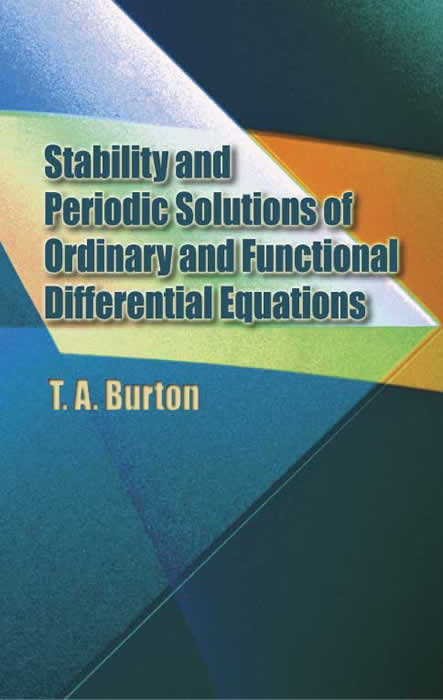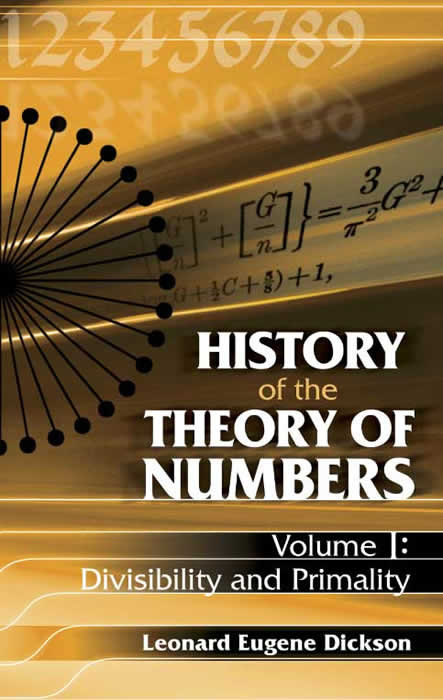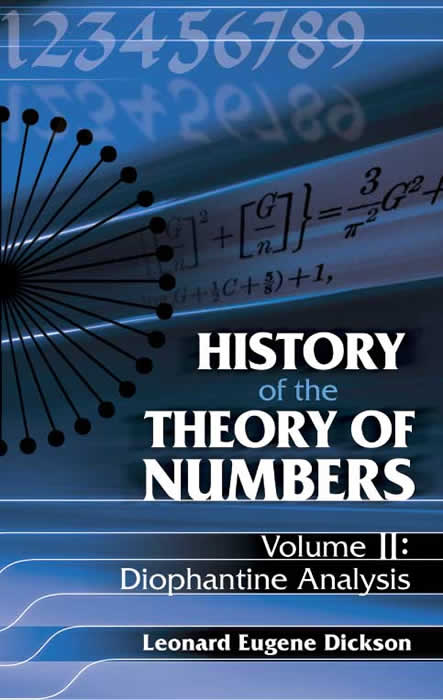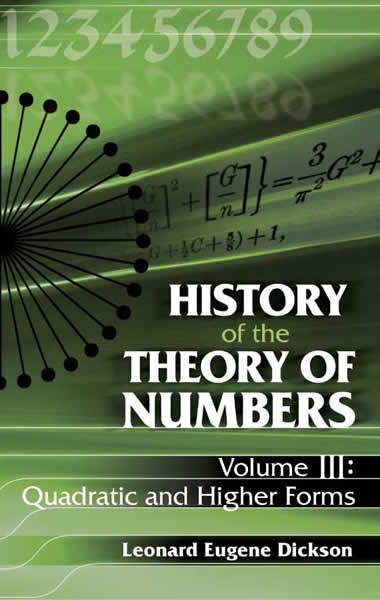T. A. Burton
Stability & Periodic Solutions of Ordinary &
Functional Differential Equations
ISBN: 0-486-44254-3
 This book's discussion of a broad class of differential equations will appeal to professionals as well as graduate students. Beginning with the structure of the solution space and the stability and periodic properties of linear ordinary and Volterra differential equations, the text proceeds to an extensive collection of applied problems. The background for and application to differential equations of the fixed-point theorems of Banach, Brouwer, Browder, Horn, Schauder, and Tychonov are examined, in addition to those of the asymptotic fixed-point theorems. The text concludes with a unified presentation of the basic stability and periodicity theory for nonlinear ordinary and functional differential equations.
This book's discussion of a broad class of differential equations will appeal to professionals as well as graduate students. Beginning with the structure of the solution space and the stability and periodic properties of linear ordinary and Volterra differential equations, the text proceeds to an extensive collection of applied problems. The background for and application to differential equations of the fixed-point theorems of Banach, Brouwer, Browder, Horn, Schauder, and Tychonov are examined, in addition to those of the asymptotic fixed-point theorems. The text concludes with a unified presentation of the basic stability and periodicity theory for nonlinear ordinary and functional differential equations.
Table of Contents
An Overview
1. Linear Differential and Integrodifferential Equations
2. History, Motivation, Examples
3. Fixed-Point Theory
4. Limit Sets, Periodicity, and Stability
References
Indexes
Leonard Eugene Dickson
History of the Theory of Numbers, Volume I: Divisibility and
Primality
ISBN: 0-486-4423-2
 This first volume in the series History of the Theory of Numbers presents in twenty chapters the material related to the subjects of divisibility and primality. At the end of the volume is a separate index of authors for each of the chapters. Volume II: Diophantine Analysis (0-486-44233-0)and Volume III: Quadratic and Higher Forms (0-486-44234-9) complete the three-volume set. Accessible and well-indexed, the three books survey the works of leading experts and can be used independently of each other.
This first volume in the series History of the Theory of Numbers presents in twenty chapters the material related to the subjects of divisibility and primality. At the end of the volume is a separate index of authors for each of the chapters. Volume II: Diophantine Analysis (0-486-44233-0)and Volume III: Quadratic and Higher Forms (0-486-44234-9) complete the three-volume set. Accessible and well-indexed, the three books survey the works of leading experts and can be used independently of each other.
Suitable for upper-level undergraduates and graduate students,
this series is the work of a distinguished mathematician who
taught at the University of Chicago for four decades and is
celebrated for his many contributions to number theory and group
theory.
Table of Contents for History of the Theory of Numbers, Volume I.
I. Perfect, multiply perfect, and amicable numbers
II. Formulas for the number and sum of divisors, problems of
Fermat and Wallis
III. Fermatfs and Wilsonfs theorems, generalizations and
converses; symmetric functions of 1, 2, ..., p-1, modulo p
IV Residue of (up-1-1)/p modulo p
V. Eulerfs function, generalizations; Farey series
VI. Periodic decimal fractions; periodic fractions; factors of 10n
VII. Primitive roots, exponents, indices, binomial congruences
VIII. Higher congruences
IX. Divisibility of factorials and multinomial coefficients
X. Sum and number of divisors
XI. Miscellaneous theorems on divisibility, greatest common
divisor, least common multiple
XII. Criteria for divisibility by a given number
XIII. Factor tables, lists of primes
XIV. Methods of factoring
XV. Fermat numbers
XVI. Factors of an+bn
XVII. Recurring series; Lucasf un, vn
XVIII. Theory of prime numbers
XIX. Inversion of functions; Mobiusf function; numerical
integrals and derivatives
XX. Properties of the digits of numbers
Indexes
Leonard Eugene Dickson
History of the Theory of Numbers, Volume ll: Diophantine
Analysis
ISBN: 0-486-44233-0
 This second volume in the series History of the Theory of Numbers presents
twenty-six chapters of material related to Diophantine Analysis. At the
end of the volume is a separate subject and author index. Volume I: Divisibility
and Primality (0-486-44232-2)and Volume III: Quadratic and Higher Forms
(0-486-44234-9) complete the three-volume set. Accessible and well-indexed,
the three books survey the works of leading experts and can be used independently
of each other.
This second volume in the series History of the Theory of Numbers presents
twenty-six chapters of material related to Diophantine Analysis. At the
end of the volume is a separate subject and author index. Volume I: Divisibility
and Primality (0-486-44232-2)and Volume III: Quadratic and Higher Forms
(0-486-44234-9) complete the three-volume set. Accessible and well-indexed,
the three books survey the works of leading experts and can be used independently
of each other.
Suitable for upper-level undergraduates and graduate students,
this series is the work of a distinguished mathematician who
taught at the University of Chicago for four decades and is
celebrated for his many contributions to number theory and group
theory.
Table of Contents
I. Polygonal, Pyramidal, and Figurate Numbers
II. Linear Diophantine Equations and Congruences
III. Partitions
IV. Rational Right Triangles
V. Triangles, Quadrilaterals, and Tetrahedra
VI. Sum of Two Squares
VII. Sum of Three Squares
VIII. Sum of Four Squares
IX. Sum of n Squares
X. Number of Solutions of Quadratic Congruences in n Unknowns
XI. Liouvillefs Series of Eighteen Articles
XII. Pell Equation
XIII. Further Single Equations of the Second Degree
XIV. Squares in Arithmetical or Geometrical Progression
XV. Two or More Linear Functions Made Squares
XVI. Two Quadratic Functions of One or Two Unknowns Made Squares
XVII. Systems of Two Equations of Degree Two
XVIII. Three or More Quadratic Functions of One or Two Unknowns
Made Squares
XIX. Systems of Three or More Equations of Degree Two in Three or
More Unknowns
XX. Quadratic Form Made an nth Power
XI. Equations of Degree Three
XXII. Equations of Degree Four
XXIII. Equations of Degree n
XXIV. Sets of Integers with Equal Sums of Like Powers
XXV. Waringfs Problem and Related Results
XXVI. Fermatfs Last Theorem
Indexes
Leonard Eugene Dickson
History of the Theory of Numbers, Volume III: Quadratic and
Higher Forms
ISBN: 0-486-44234-9
 This third volume in the series History of the Theory of Numbers presents
nineteen chapters of material related to Quadratic and Higher Forms. Volume
III is mainly concerned with general theories rather than with special
problems and special theorems. The investigations deal with the most advanced
parts of the theory of numbers. At the end of the volume is a separate
subject and author index. Volume I: Divisibility and Primality (0-486-44232-2)and
Volume II: Diophantine Analysis (0-486-44233-0) complete the three-volume
set. Accessible and well-indexed, the three books survey the works of leading
experts and can be used independently of each other.
This third volume in the series History of the Theory of Numbers presents
nineteen chapters of material related to Quadratic and Higher Forms. Volume
III is mainly concerned with general theories rather than with special
problems and special theorems. The investigations deal with the most advanced
parts of the theory of numbers. At the end of the volume is a separate
subject and author index. Volume I: Divisibility and Primality (0-486-44232-2)and
Volume II: Diophantine Analysis (0-486-44233-0) complete the three-volume
set. Accessible and well-indexed, the three books survey the works of leading
experts and can be used independently of each other.
Suitable for upper-level undergraduates and graduate students,
this series is the work of a distinguished mathematician who
taught at the University of Chicago for four decades and is
celebrated for his many contributions to number theory and group
theory.
Table of Contents for History of the Theory of Numbers, Volume
III
I. Reduction and Equivalence of Binary Quadratic Forms,
Representation of Integers
II. Explicit Values of x, y
III. Composition of Binary Quadratic Forms
IV. Orders and Genera; Their Composition
V. Irregular Determinants
VI. Number of Classes of Binary Quadratic Forms With Integral
Coefficients
VII. Binary Quadratic Forms Whose Coefficients Are Complete
Integers or Integers of a Field
VIII. Number of Classes of Binary Quadratic Forms with Complex
Integral Coefficients
IX. Ternary Quadratic Forms
X. Quaternary Quadratic Forms
XI. Quadratic Forms in n Variables
XII. Binary Cubic Forms
XIII. Cubic Forms in Three or More Variables
XIV. Forms of Degree n>4
XV. Binary Hermitian Forms
XVI. Hermitian Forms in n Variables and Their Conjugates
XVII. Bilinear Forms, Matrices, Linear Substitutions
XVIII. Representation by Polynomials Modulo p
XIX. Congruencial Theory of Forms
Indexes
Lieb, E.H., Seiringer, R., Solovej, J.P., Yngvason, J.
The Mathematics of the Bose Gas and its Condensation
Series: Oberwolfach Seminars, Vol. 34
2005, VIII, 208 p., Softcover
ISBN: 3-7643-7336-9
About this textbook
 This book contains a unique survey of the mathematically rigorous results
about the quantum-mechanical many-body problem that have been obtained
by the authors in the past seven years. It is a topic that is not only
rich mathematically, using a large variety of techniques in mathematical
analysis, but it is also one with strong ties to current experiments on
ultra-cold Bose gases and Bose-Einstein condensation. It is an active subject
of ongoing research, and this book provides a pedagogical entry into the
field for graduate students and researchers. It is an outgrowth of a course
given by the authors for graduate students and post-doctoral researchers
at the Oberwolfach Research Institute in 2004. The book also provides a
coherent summary of the field and a reference for mathematicians and physicists
active in research on quantum mechanics.
This book contains a unique survey of the mathematically rigorous results
about the quantum-mechanical many-body problem that have been obtained
by the authors in the past seven years. It is a topic that is not only
rich mathematically, using a large variety of techniques in mathematical
analysis, but it is also one with strong ties to current experiments on
ultra-cold Bose gases and Bose-Einstein condensation. It is an active subject
of ongoing research, and this book provides a pedagogical entry into the
field for graduate students and researchers. It is an outgrowth of a course
given by the authors for graduate students and post-doctoral researchers
at the Oberwolfach Research Institute in 2004. The book also provides a
coherent summary of the field and a reference for mathematicians and physicists
active in research on quantum mechanics.
Written for:
Graduate students and researchers in mathematical and theoretical physics interested in the quantum-mechanical many-body problem, statisticians
Table of contents
 This book's discussion of a broad class of differential equations will appeal to professionals as well as graduate students. Beginning with the structure of the solution space and the stability and periodic properties of linear ordinary and Volterra differential equations, the text proceeds to an extensive collection of applied problems. The background for and application to differential equations of the fixed-point theorems of Banach, Brouwer, Browder, Horn, Schauder, and Tychonov are examined, in addition to those of the asymptotic fixed-point theorems. The text concludes with a unified presentation of the basic stability and periodicity theory for nonlinear ordinary and functional differential equations.
This book's discussion of a broad class of differential equations will appeal to professionals as well as graduate students. Beginning with the structure of the solution space and the stability and periodic properties of linear ordinary and Volterra differential equations, the text proceeds to an extensive collection of applied problems. The background for and application to differential equations of the fixed-point theorems of Banach, Brouwer, Browder, Horn, Schauder, and Tychonov are examined, in addition to those of the asymptotic fixed-point theorems. The text concludes with a unified presentation of the basic stability and periodicity theory for nonlinear ordinary and functional differential equations.  This first volume in the series History of the Theory of Numbers presents in twenty chapters the material related to the subjects of divisibility and primality. At the end of the volume is a separate index of authors for each of the chapters. Volume II: Diophantine Analysis (0-486-44233-0)and Volume III: Quadratic and Higher Forms (0-486-44234-9) complete the three-volume set. Accessible and well-indexed, the three books survey the works of leading experts and can be used independently of each other.
This first volume in the series History of the Theory of Numbers presents in twenty chapters the material related to the subjects of divisibility and primality. At the end of the volume is a separate index of authors for each of the chapters. Volume II: Diophantine Analysis (0-486-44233-0)and Volume III: Quadratic and Higher Forms (0-486-44234-9) complete the three-volume set. Accessible and well-indexed, the three books survey the works of leading experts and can be used independently of each other.  This second volume in the series History of the Theory of Numbers presents
twenty-six chapters of material related to Diophantine Analysis. At the
end of the volume is a separate subject and author index. Volume I: Divisibility
and Primality (0-486-44232-2)and Volume III: Quadratic and Higher Forms
(0-486-44234-9) complete the three-volume set. Accessible and well-indexed,
the three books survey the works of leading experts and can be used independently
of each other.
This second volume in the series History of the Theory of Numbers presents
twenty-six chapters of material related to Diophantine Analysis. At the
end of the volume is a separate subject and author index. Volume I: Divisibility
and Primality (0-486-44232-2)and Volume III: Quadratic and Higher Forms
(0-486-44234-9) complete the three-volume set. Accessible and well-indexed,
the three books survey the works of leading experts and can be used independently
of each other.  This third volume in the series History of the Theory of Numbers presents
nineteen chapters of material related to Quadratic and Higher Forms. Volume
III is mainly concerned with general theories rather than with special
problems and special theorems. The investigations deal with the most advanced
parts of the theory of numbers. At the end of the volume is a separate
subject and author index. Volume I: Divisibility and Primality (0-486-44232-2)and
Volume II: Diophantine Analysis (0-486-44233-0) complete the three-volume
set. Accessible and well-indexed, the three books survey the works of leading
experts and can be used independently of each other.
This third volume in the series History of the Theory of Numbers presents
nineteen chapters of material related to Quadratic and Higher Forms. Volume
III is mainly concerned with general theories rather than with special
problems and special theorems. The investigations deal with the most advanced
parts of the theory of numbers. At the end of the volume is a separate
subject and author index. Volume I: Divisibility and Primality (0-486-44232-2)and
Volume II: Diophantine Analysis (0-486-44233-0) complete the three-volume
set. Accessible and well-indexed, the three books survey the works of leading
experts and can be used independently of each other.  This book contains a unique survey of the mathematically rigorous results
about the quantum-mechanical many-body problem that have been obtained
by the authors in the past seven years. It is a topic that is not only
rich mathematically, using a large variety of techniques in mathematical
analysis, but it is also one with strong ties to current experiments on
ultra-cold Bose gases and Bose-Einstein condensation. It is an active subject
of ongoing research, and this book provides a pedagogical entry into the
field for graduate students and researchers. It is an outgrowth of a course
given by the authors for graduate students and post-doctoral researchers
at the Oberwolfach Research Institute in 2004. The book also provides a
coherent summary of the field and a reference for mathematicians and physicists
active in research on quantum mechanics.
This book contains a unique survey of the mathematically rigorous results
about the quantum-mechanical many-body problem that have been obtained
by the authors in the past seven years. It is a topic that is not only
rich mathematically, using a large variety of techniques in mathematical
analysis, but it is also one with strong ties to current experiments on
ultra-cold Bose gases and Bose-Einstein condensation. It is an active subject
of ongoing research, and this book provides a pedagogical entry into the
field for graduate students and researchers. It is an outgrowth of a course
given by the authors for graduate students and post-doctoral researchers
at the Oberwolfach Research Institute in 2004. The book also provides a
coherent summary of the field and a reference for mathematicians and physicists
active in research on quantum mechanics.